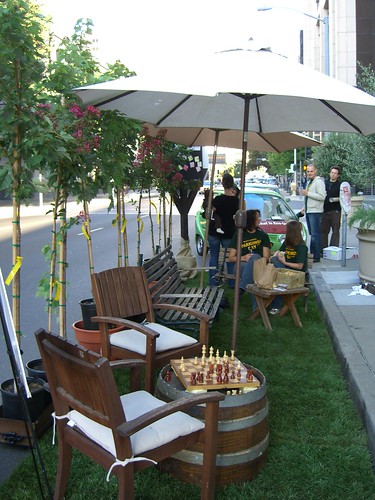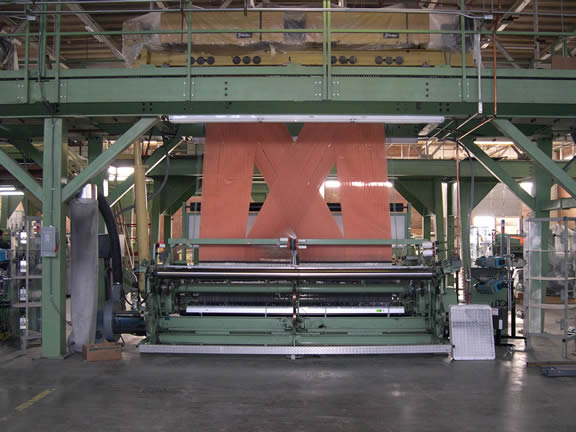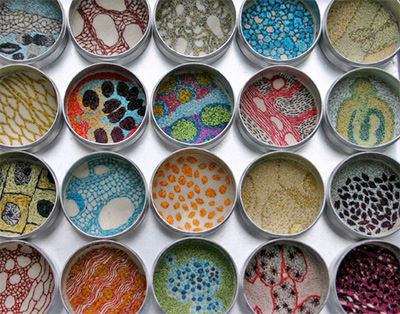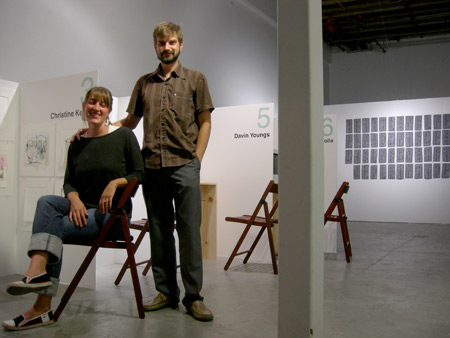Friday, Sept. 19th is PARK(ing) Day
blog events good things neat projects
 
Rebar has teamed up with The Trust for Public Land to create National PARK(ing) day. Make your own park, however temporary. Find parks near you!
blog events good things neat projects
 
Rebar has teamed up with The Trust for Public Land to create National PARK(ing) day. Make your own park, however temporary. Find parks near you!
blog good things internet neat projects
Orlagh O’Brien did a project that asked participants about five emotions: joy, anger, fear, sadness, and love. He asked them to represent where in the body they felt those emotions, how the body feels those emotions, the direction of those emotions, the things that create those emotions, and the color of those emotions.
His easy to use website dipicts the compilation of the answers to those questions. Neat project and interesting results.
bay area blog events good things making of news subscription art TPG7
Collecting Textile Art – information on the broad range of textiles in the market, along with tips about displaying and collecting
When is Fiber Art, Art? An essay in Fiber Arts Magazine (a good source of info for all things related to (surprise!) fiber arts) by Janet Koplos
 The Jacquard Loom is a mechanical loom, invented by Joseph Marie Jacquard in 1801, that has holes punched in pasteboard, each row of which corresponds to one row of the design. Multiple rows of holes are punched on each card and the many cards that compose the design of the textile are strung together in order.
The Jacquard Loom is a mechanical loom, invented by Joseph Marie Jacquard in 1801, that has holes punched in pasteboard, each row of which corresponds to one row of the design. Multiple rows of holes are punched on each card and the many cards that compose the design of the textile are strung together in order.
Because it was the first machine to use punch cards to control a sequence of operations, it is considered an important step in the history of computing hardware. The ability to change the pattern of the loom’s weave by simply changing cards was an important conceptual precursor to the development of computer programming.
Fiber Artists and Shows:
Thread at Johansson Projects: a review of the show, a list of artists involved “Thread, a survey of sewn, stitched and woven works whose common thread is the media, not the medium. By re-exploring the functional avenues of textiles and materials, these eight artists begin to converse in a neo-craft dialect which diverges greatly from its domestic and industrial traditions. Pins are re-invented as figurative joinery, refuse amassed to render owls, interactive fabric measures changes in electro-magnetic frequencies, making the outcome from these dexterous hands undeniably rare.”
Two artists from the “Thread” show work with the Jacquard loom: “Lia Cook, collected by the Cleveland Museum, de Young, The Met, and NYMOMA and her former student, Christy Matson, who currently lectures at The School of the Art Institute of Chicago, both utilize Jacquard weaving looms though their kinship divides from there: Matson’s interactive woven audio cloth relays the constant human flux of the very space Cook’s pointillist portraiture hopes to hold in a single woven moment.”
Anni Albers – was a German-American textile artist and printmaker. She is perhaps the best known textile artist of the 20th century. In 1971, her and her husband founded the Josef and Anni Albers Foundation, a not-for-profit organization they hoped would further “the revelation and evocation of vision through art.” Here is a gallery of Albers’ work much of which is strikingly similar to Text/ile. Here is a great interview with Anni that gives some insight into her work and theories.
Seiko Kinoshita – contemporary textile artist from Japan working out of England.
Deepa Panchamia – contemporary sculptural textile artist out of England
Emilio Lobato – Painter inspired by woven textiles. Honoring the weavers of his Spanish ancestry, Lobatos’ new work revisits the ‘Blanket’ series and builds upon its tapestry-like foundation. With inclusions of text and cross symbols, the weft segments are painted the artists trademark colors: earthen reds, blacks and ochres.
Maggie’s Links:
http://www.visualcomplexity.
is an AMAZING site that really inspires me on many different levels.
this is a great group that combines knitting and graffiti.
This is the web site for Cat Mazza who is using stitching and knitting for revolution and activism.
radicalcrossstitch.com/2008/
A new project collaborative–way cool feminist site!
The Jacquard Center in Henderson, North Carolina – Text/ile was produced while Maggie was an artist in residency here.
Fiber Arts as Activism:
Stitch for Senate is an initiative of knit hobbyists making helmet liners for every United States Senator. Building on the tradition of wartime knitting, a practice dating back to the American Revolution, Stitch for Senate revives this cultural trend by engaging with public officials about the war in Iraq. Hobbyists knit in solidarity to persuade elected officials to support the troops by bringing them home. All the senators will receive their own helmet liner the week of the 2008 election, after being displayed in the seating chart of the US Senate at gallery venue. Once they are received, senators can opt to send helmets to a soldier.
contemporary art criticism TPG7
“It’s a kind of microscopic herd mentality…Cells figure out which passages [in DNA] to pay attention to by observing signals from the cells around them: only with that local interaction can complex neighborhoods of cell types come into being.”
–Steven Johnson, Emergence
“It is safe, I suppose, to assume that today most if not all of us have had the experience of looking down from an airplane onto this earth. What we see is a free flow of forms intersected here and there by straight lines, rectangles, circles and evenly drawn curves; that is, by shapes of great regularity…[H]ere before us we can recognize the essence of designing, a visually comprehensible, simplified organization of forms that is distinct from nature’s secretive and complex working.”
–Anni Albers, “Designing As Visual Organization”
A white plastic box inscribed with a colorful legend, anonymously medical or scientific in origin, opens to reveal a woven textile, folded upon itself, black and white threads that merge into a shifting pattern of gray rectangles. Unrolled and displayed vertically, the swatch immediately brings to mind the reductive shapes and optical experimentation of Modernist abstraction. If pressed for a literal reference, I might say that the textile looks like nothing so much as the generically industrial, grainy landscapes of aerial photography: a cluster of buildings, parking lots, a straight road.
However, the framing–the ambiguously medical plastic, the charts on the sticker, with terms like “probes” and “polymorphism”–hints at a different meaning in the flat gray shapes. Because in fact Maggie Leininger’s “Text/ile” does have a literal reference, and it is in the basic informational structure of the human body. For this project, scientific diagrams of chromosomes–8 of the 23 found in human cells–have been reduced to grayscale patterns composed of black and white thread and woven on a Jacquard Loom into textiles remarkable in how they bring to mind not data but the abstract patterns of Modernist design.
Maggie Leininger works systematically on these multiple layers of representation and reference, finding within the building blocks of life hints of other forms, of city blocks and aerial topographies. Here the forms of Modernism, once so carefully divorced from literal reference, are found to contain the elemental information that guides the functioning of human cells. In her previous works the connection between microscopic and macroscopic forms was even more overt. In “Specimen” (2004) aluminum cylinders–resembling specimen jars or assay plates–are stitched with colorful patterns that could be cells seen under the microscope, could be colonies of bacteria on a petri dish, or could equally be mineral deposits in an estuary viewed from an airplane window.

Specimen by Maggie Leininger (2004)
In science the curious repetition of forms across multiple scales is a familiar idea. The term “self-similarity” describes a form that can be broken down into infinitely smaller parts, each a tiny likeness of the first. Self-similarity is behind the recursively complex structures of fractal geometry, perhaps familiar from its brief popularity in the early years of digital art. In nature self-similarity is more approximate, but is clearly present in forms like Romanesco broccoli or the way a tree trunk branches off into branches into branches…. Self-similarity has a central place in Complexity theory, which attempts to describe the way in which infinitely complex systems can arise from the interaction of a few simple rules or processes. This, too, is an idea obliquely referenced in Leininger’s work, concerned as she is with the simple structures that combine to form organisms and superorganisms. Complexity displays across many scales, from micro to macro: from the way that cells form an organism to the way that a few settlements form neighborhoods, which in turn weave themselves into a city. Complexity theory and the principle of Emergence seek to describe the ways in which these complex structures come into being without organized planning, without top-down interference from a central authority. Leininger has a stated interest in the systems behind urban structures, in neighborhoods bounded by the “invisible lines known only by the inhabitants,” and so it makes sense that she would find hints of the automatic, organic assembling of cells in a city seen from a great height.
And so the curious slash in the title, “Text/ile”, deliberately breaking out the word “text”, underscores perhaps how meaning is a similar system, how it is woven by the combination of words, how words themselves can be broken down into phonemes, into letters, themselves the building blocks of communication. Like cells or a city, language is a complex system built from the interactions of simple rules. The three poems meant to accompany the piece hint at a personal narrative not necessarily present in a representation of human chromosomes, with concepts like ‘artifact’, ‘birth’, ‘death’, ‘memory’ acting as ciphers to suggest whatever simple concept, whatever hidden connotations, they hold for each of us. Yet DNA is, in a sense, an artifact, a legacy woven through generations of organisms, and the Human Genome Project treats DNA almost as a language, as a code that can be cracked.
Ultimately with “Text/ile” these references are shadowed by the overwhelming allusion to Modernist design in the woven swatches, and here perhaps is where the most interesting connective thread peeks out from the weave. There is an obvious aesthetic precedent in the work of Anni Albers, textile artist and member of the Bauhaus, a German craft and design school highly influential in popularizing Modernist design philosophy in the first quarter of the twentieth century. Albers, equally fascinated by language, wrote extensively on design, and, along with Bauhaus colleagues like Walter Gropius and her husband, Josef Albers, helped to publicize a modern aesthetic that focused on radically reduced shapes, an emphasis on rationality and the harmony of form and function. Modernism as a movement affirmed mankind’s relentless march into the future, aided by the constant progress and improvements allowed by science and technology.
The vision afforded to the Modernist subject is rational, clinical and–aided by advancements in optics like the camera, the microscope–Modernist vision is unparalleled in its powers of observation, its ability to see the world across a range of scales, from deep into the cell to deep into the cosmos. The viewer of “Text/ile”, armed with the technological heir to this Modernist eye, takes what writer and complexity theorist Steven Johnson calls “the long zoom”: a perspective that shifts fluidly from the macro to the micro. In fact, it is a sort of “god’s eye view” that forms the connective thread between all of Leininger’s works, the way in which whatever is represented is represented as from above, whether it is through the lens of a microscope or a spy satellite. In the forms that comprise her work the viewer is given the benefit of a distance that makes vague the distinctions between the very small and the very large in order to emphasize their visual similarity at all scales. Modernism grants the eye the power to reduce the world into its constituent parts, to arrange even our bodies into a text that can be read and understood. Where once pictorial tapestries might have advertised the power and riches of the nobles, Leininger’s textile works seem to affirm the optical power of modernity, our ability through science to apprehend the world from the microscopic elements of the human body to the daily actions and interactions that form the structure and life of a city.

Ancient Writing by Anni Albers (1936)
Nature, certainly no less complex than in Anni Alber’s time, but perhaps a great deal less “secretive”, has in Leininger’s work arrayed itself like a text for human viewing. And humans are furnished with a power of vision once reserved for gods. Seen from above, the distinctions between the design of cities and the organic forms of nature are much less pronounced than when Albers wrote “Designing as Visual Organization”, woven as they are from simple patterns and rules, iterated outward into works of infinite complexity.
.
.
.
.
Andrew Venell is a designer, hypertext author and multimedia artist whose works explore issues of urbanism, surveillance, commerce and mass communication.
artist interviews Artist Interviews TPG7
Maggie Leninger was interviewed via Skype on August 26th, 2008 by Oliver Wise and Eleanor Hanson Wise of The Present Group.
Listen: (~32:00)
blog events good things tidings
We had a big night on Friday. It was really wonderful to have a space to show all the works that we, the artists, and the subscribers have collaboratively created throughout the past two years. It was great to meet some of our subscribers for the first time, greet our friends and supporters of old, and share with people we just met our project and the works. Two of our artists were able to make an appearence, which was great, along with three of our critics (one future curator/critic).
We felt very proud to be able to share these works and honored at the turnout. It was also so heartwarming to know that the show was made possible by contributions from so many people. And so..
Thanks to:
Old Oakland PSAI Associates for the space, Illinois Arts Council for partial funding of Maggie’s project, Vino! and Ally and Justin Trigg for their generous donations of wine, Southern Exposure and the Alternative Exposure Grant for much needed funds, Tim and Lydia for the projector, Steve, Paul, Elissa, Christine, Ally, and Andy and Lauren for the loans of mp3 players and headphones, Lauren and Andy for day of tasks, Verse and 510 for welcoming us so kindly to the little strip, all of our subscribers, artists, critics, friends, and all those who made the trip.
We are so honored and grateful for your help, support, and enthusiasm.

Lego Hello World
I wish all my printers were made of legos.
LIFE photo archive hosted by Google
Images from Life Magazine going back to 1860′s, hosted by Google
Coming Face To Face With The President
Well crafted story about an under-heard point of view.
In California, Pot Is Now an Art Patron
A new funding source for the arts – reaping big rewards and funding many projects. It’s pot.
Notes on Portraiture in the Facebook Age
Celebrity Book Club: A List to End All Lists
Because, well, it’s sortof awesome.
Are "Artists' Statements" Really Necessary?
The pros and cons about that nemesis for most artists.
This to That
You tell it what you’ve got and it’ll tell you what to glue them together with.
Work of art: Online store for buyers, sellers
Not the TV show! Kelly Lynn Jones from Little Paper Planes is interviewed on her project, gives us a cheat sheet to local affordable art resources.